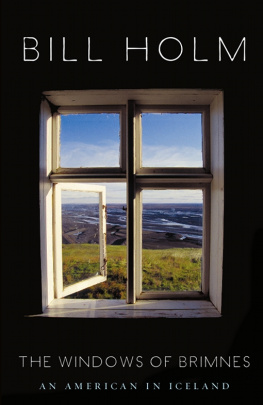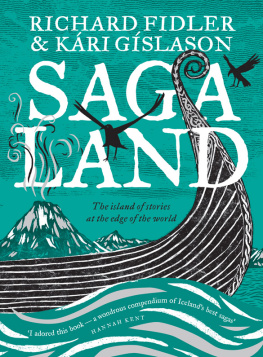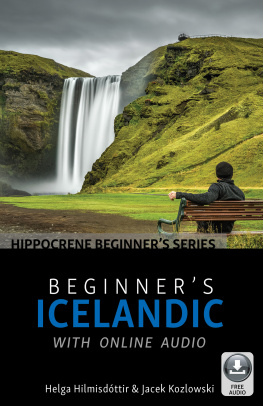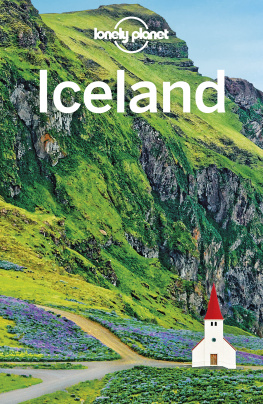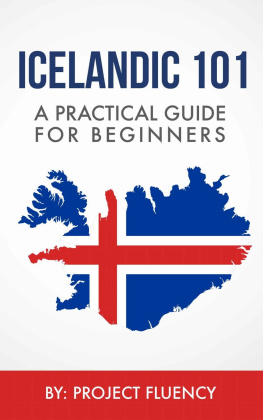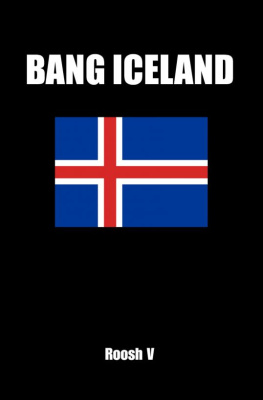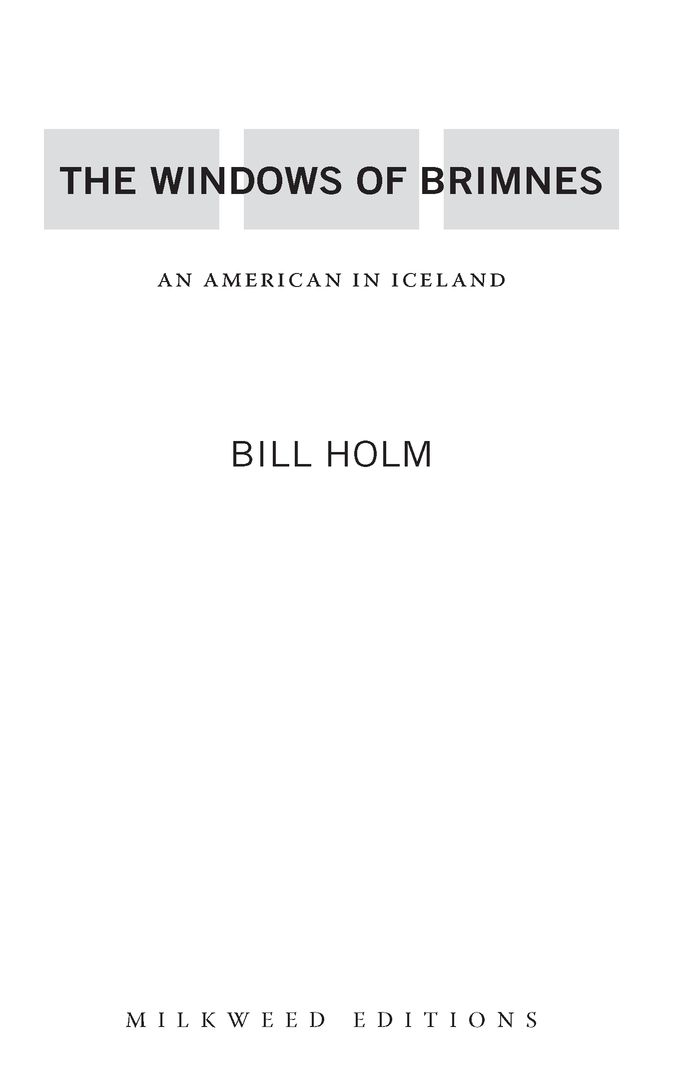Table of Contents
ALSO BY BILL HOLM
NONFICTION
Coming Home Crazy: An Alphabet of China Essays
Eccentric Islands: Travels Real and Imaginary
The Heart Can Be Filled Anywhere on Earth
POETRY
Boxelder Bug Variations
The Dead Get By with Everything
Playing the Black Piano
For Kristjn rnason, poet, carpenter, maker of beauty from wood and words, a representative type of the Icelandic farmer-intellectual who refused to let either isolation or poverty keep him from practicing his art.
THE WINDOWS OF BRIMNES
AN AMERICAN IN ICELAND
| Brimnes: Name and Place | 3 |
| Skagafjrur | 19 |
| Ethereal Friends | 31 |
| Elves Out the Windows | 63 |
| The Melancholy Quotient | 73 |
| Minneota: The Early Years | 109 |
| Silence and Noise | 131 |
| A Gift of Horses | 159 |
| Christianity Under the Glacier | 173 |
| The Home of Poetry | 189 |
| Fog | 203 |
No book is ever made without the wisdom and generosity of friends. I list them as the alphabet finds them. A thousand thanks.
David Arnason
Kristjn rnason
Margret and rn Arnar
Sverrir sgrmsson
Fred Bjarnason
Carol Bly
Robert Bly
Marcy Brekken
Emilie Buchwald
Nelson Gerrard
Daren Gslason
Hallgrmur Gunnarsson
Tom Guttormsson
Margret Klka Haraldsdottir
Jn Baldvin Hannibalsson
Anna Sigga Helgadttir
Var Hreinsson
Wincie Jhannsdottir
slaug Jnsdottir
Cathy Josephson
Charles and Joan Josephson
Les and Donna Josephson
Jn Magnusson
Gail Perrizo
David Pichaske
Brynds Schram
John and Lorna Rezmerski
Dagmar sdis orvaldsdottir
rnalur orvaldsson
Valgeir orvaldsson
Doris and Don Wenig
And of course,
Daniel Slager
Hilary Reeves
Emily Cook
Patrick Thomas
Jim Cihlar
And the whole gang at
Milkweed Editions
With particular thanks to the
Icelandic translation squad:
Wincie Jhannsdottir
Margret Arnar
Margret Klka Haraldsdottir
Wallgrmur Gunnarsson
Nelson Gerrard
slaug Jnsdottir
BRIMNES: NAME AND PLACE
In the summer of 2001, a journalist from St. Paul, Minnesota, a young woman with a sense of adventure, decided to spend a week touring Iceland. I invited her to stop by and see me in Hofss. Theres no address, I said. There are only a few hundred people, and they will all know how to find the crazy American. Just ask for Brimnes. Im next to the sea. And if you cant find the sea, youre out of luck.
She landed at Keflavk International Airport at 6:00 A.M., rented a car, and decided to drive straight north. She found Highway 1, Esja, the tunnel, the pass, even the country music station, and finally the turn off Highway 1 to Hofss. The sun shone grandly. Wildflowers bloomed dependably in the ditches, the motor purred, and the sight of the sea and the mountains helped stave off the jet lag.
She drove north with open windows and a glad heart. Soon a drink, lunch, a nap, a friendly and familiar American face. Suddenly she hit the brakes and stopped, ten miles south of Hofss. By the side of the road was a blue metal sign: Brimnes. It pointed toward the fjord to the east. He hadnt said whether he lived right in town. This must be it. She turned west down a long gravel driveway, passed through a gate which she responsibly closed behind her, and arrived at a farmstead with a real barn, a corral of horses, a stack of hay bales wrapped in plastic, a tractor, but an empty yard. So hes bought a farm, she thought, and got out to stretch her legs. Out from the barn came a young farmer in black rubber boots and a blood-soaked slicker. Behind him trotted his five- or six-year-old daughter, same rubber boots, same slicker, but smaller, carrying a bleeding sheeps head.
Is this Brimnes? asked a now-confused Amy.
Brimnes? J. etta er Brimnes, said the farmer, clearly astonished at the sound of English, a language he probably neither speaks nor understands and also not the lingua franca of the neighborhood. The little girl with the sheeps head examined the pretty young foreigner in the shiny rental car. Go to the house and fetch your mother, said the farmer in Icelandic to his daughter. She understands a little English.
Soon the mother emerged, wiping floury hands on her apron. Amy explained again that she was looking for Bill Holm, an American living at Brimnes. Oh, not this Brimnes, said the mother in halting English. Kannski hann br in town Hofss, fifteen kilometers north. Brimnes there too, I think.
Amy thanked the family in her best English, apologizing, with her sweetest American smile, for interrupting the sheep butchering, and drove back down the way she came, carefully closing the gate behind her. Fifteen minutes later she found me, not in Brimnes but rather at the end of a telephone line. Shed stopped at the little general store (the only store in Hofss), and when she inquired after Bill Holm, Dagn, the blond clerk and postmistresss daughter, told her I was probably having coffee down at the Icelandic Emigration Center, but that shed ring there and track me down. All this, much to Amys relief, in fluent English. I was summoned to the phone. Did you have a good trip up? You must be half-dead of jet lag.
I had a little adventure, said Amy.
Such is life in Iceland. One of its great pleasures, in fact.
This had been Amys first experience with the Icelanders habit of naming every farm, every house, and of course every rock, rise, gully, and bay in this mostly empty landscape. Brim means waves or surf breaking on the beach, nes means cape, promontory, or headland, thus Brimnesa miniature peninsula. Most of the country lives within spitting distance of salt water, which means there must be at least fifty Brimneses scattered over all districts of Iceland. Names repeat themselves endlessly: a hundred Hrauns (lava); farms called Vatn (lake or water), Br (farmstead), Br (bridge), and s (rivers mouth). The local trolls worship at many churches: the mountain Trllakirkja. Or perhaps they dine at the west fjord rocks called Trollasamlokurtroll sandwiches. And as with places, so with humans. I was once kissed by eight Gurns in one night, and shook hands with a dozen Bjrns. Are Americans short of Johns and Marys?
Without a name, does a place exist? And what is the right name? And who is the right giver of names? Iceland is, if not the last, one of the few countries in the world to use a system of patronymics, in which the first name is the real identifier and the last only a temporary convenience used to establish connections between generations. If you wish to find a Gurn or a Bjrn in Iceland, you must consult the telephone directory by first name. You may find twenty Gurn Bjrnsdttirs in Reykjavk alone. Start ringing at the top of the list. Good luck. Eventually one of the Gurns will know the one you are looking for and provide you with the right number. With 300,000-odd Icelanders, anonymity may be completely impossible. An American can disappear and invent a new name, a new identity, but dont try it in Iceland. Someone will know....
Houses in country villages have names as well. Many farms have had the same name for a thousand years, even if the existing turf house has actually been built upon the remains of another. After all, it has been the same old

